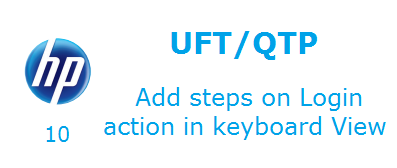In previous article we have learned about “Overview of UFT Functions and Function Libraries“. Today Let‘s know how to use Keyboard view to work on Login Action in UFT.
Keyboard view represents each action in a step performs by UFT on a particular application.
In this exercise, we will make a flight reservation from New York to San Francisco on the Mercury Tours Web site and will add and show actions performed during this reservation process in step in keyboard view.
First, in UFT window, open the Mercury Tours test and making sure that only the Web Add-in is loaded.
To do so, open UFT, the start page opens. On the Start page, go to the “Recent Solutions” area and click on “Mercury Tours1” to open it. The Mercury Tours1 solution opens.
Second, Open and display the Login action in Keyword View.
If the canvas of Login action is not opened, go to the document pane of the Mercury Tours tab and double-click the Login action. The Login action opens.
If the Login action pane displays in Editor view mode, change it to the Keyword View by clicking on Keyword View button or by View à Keyboard View.
Third, add the first step to Login action.
In the opened Keyword View window, select the Item by directly clicking on the Login row. The Item list opens with object repository and other options. Here, the first test object is the Welcome: Mercury Tours browser object, shown in the given below figure.
Add steps only on objects on which you want to perform operations.In Keyboard view, from the item list, select“Object from repository” to open the Select Test Object dialog box.Select Test Object dialog box opens.
In Select Test Object dialog box, expand the test object tree and select username and click “OK”, shown in the figure below.
Close the Select Object for Step dialog box. This will add steps to the action with three rows, shown in the figure below.
These three rows are added by UFT for each of the parent test objects, but UFT does not perform an operation on these objects. These rows show the part of the object on which the step has been performed.
During a runtime, UFT uses the parent objects to detect the real object on which it needs to execute an operation.
In the given below figure,
Last selected row of item cell displays userName as a WebEdit test object. The Operation cell displays default method “Set”. The Documentation cell displays text indicates that this step clears the text in the edit box. The Value cell field is missing and needs to be a field with the required value.
In the Value cell, enter Mercury Tours1.
The step gets over after adding value. When you click another area in the Keyword View, the documentation for this step is updated in the Documentation cell.
For all above process, Editor displays the syntax in VBScript language.
| Browser(“Welcome: Mercury Tours”).Page(“Welcome: Mercury Tours”).WebEdit(“userName”).Set “Mercury Tours1” |
To go to Editor View, select View > Editor or click on Editor View button.
Again, click on the Keyword View button to return to the Keyword View.
Fourth, add the next step.
To add the next step, click below the userName row of the Item column. The Item list opens, listing the previous step test object.
Select “password” from the Item list. This adds only one new row because the object shares the same parent objects as the previous step.
Here, Item cell added passwordWebEdit test object.
Operation cell added default method “Set”. Although password should be encoded form, this method needs to be changed.
The Documentation cell displays text, indicates that this step clears the text in the edit box. This is because the value is missing in the Value cell, and needs to be updated with the password.
Click the Operation cell down arrow to display a list of methods for the selected test object. From the list, choose “SetSecure” facilitates to use the encrypted text. Generate the encrypted text and put it in the Value cell.
Fifth, use the HP Password Encoder application to create an encoded password.
To do so, go to Tools > Password Encoder. The Password Encoder dialog box opens.
In Password Encoder dialog box, enter Password: Mercury Tours1 and click on “Generate”. The Password Encoder encrypts the password and shows it in the Encoded String box then click on Copy button and Paste the encoded value in the Value cell for the password step, Document cell displays the detail of this step. Close the Password Encoder dialog box.
If you run your action at this point, UFT would automatically open the Mercury Tours Web site and insert the values you specified in the User Name and Password boxes.
Sixth, add the last step in the Login action.
Click on the last step, in the Item column to add the next step.
The Item list opens, select sign-in from the item list. Follow above technique to add a step.
This step instructs UFT to click Sign-In on the Welcome page and log in to the Mercury Tours site.
Seventh, save the test by going to File > Save.
Expand or Collapse the Login Action
In the Keyboard view, under the Item column, click the branch arrows to expand or collapse each Web page steps. Also, can collapse or expand each step by selecting the action name at the top and then go to View > Collapse All or View > Expand All.
When you expand your action, it should look similar to this,
The steps created for Login Action:
⇓ Subscribe Us ⇓
If you are not regular reader of this website then highly recommends you to Sign up for our free email newsletter!! Sign up just providing your email address below:
Happy Testing!!!
Other Tutorial Series
Happy Testing!!!
